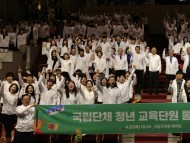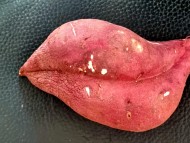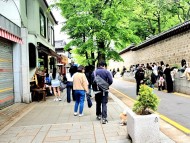2024.04.27 (토)
The National Palace Museum of Korea, an affiliate of the Cultural Heritage Administration of Korea, has selected
- Michael Lammbra…
- 등록 2023.02.01 19:04
- 조회수 44,145
The National Palace Museum of Korea, an affiliate of the Cultural Heritage Administration of Korea, has selected
"Sachet Pouch with Designs of Peonies and Buddha’s Hand Citrus” as its "Curator’s Choice from the Royal Treasures” for the month of February. Starting February 1, the pouch will be on display in the Royal Court Life Gallery on the second floor of the museum.
The pouch, which is presumed to have belonged to Imperial Prince Yeong (1897?1970; also known as King Yeongchin), is characterized by a round form. It still contains aromatic materials wrapped in traditional Korean mulberry pulp paper (hanji). The pouch was part of a group of 333 items of clothing and accessories once belonging to the family of Imperial Prince Yeong that were returned from Japan to Korea in 1991. Under the title "Clothes and Accessories Worn by King Yeongchin and His Family,” they were designated by the South Korean government as National Folklore Cultural Heritage and are currently housed in the National Palace Museum of Korea.
Imperial Prince Yeong (1897 - 1970; birth name: Yi Eun) was the seventh son of King Gojong. He was the last imperial prince of the Korean Empire.
Clothes and Accessories Worn by King Yeongchin and his family is a collection of 333 pieces of clothing and accessories once belonging to the family of Imperial Prince Yeong. They were originally held by the consort of the imperial prince, but were later sent to the National Museum of Tokyo for management. In 1991, the items were returned to Korea in accordance with an agreement signed between South Korea and Japan regarding the transfer of clothing originating with the family of Imperial Prince Yeong.
Demonstrating the sophisticated crafting applied to court sachet pouches, this cultural heritage item is made of unpatterned red silk gauze on one side and unpatterned yellow silk gauze on the other. Both sides are embroidered with large designs of peonies combined with smaller designs of Buddha’s hand citrus and small flowers. The opening of the pouch features fifteen pleats threaded with a flat braided string dyed navy blue and finished at either end with a glass bead. The designs of peonies and Buddha’s hand citrus were elaborately embroidered using couching stitches. They respectively symbolize wealth and honor and longevity, and also express wishes for the prosperity of the imperial court.
In addition to being displayed in the museum gallery, this month’s Curator’s Choice ? Sachet Pouch with Designs of Peonies and Buddha’s Hand Citrus ? will be presented virtually through a video on the YouTube channels of the museum and the Cultural Heritage Administration of Korea.
- [] 제16회 순천 낙안읍성 전국가야금병창경연대회(05/25-26)
- [] 제18회증평국악경연대회(05/11)
- [] [군산]제32회 전국청소년민속예술경연대회(05/18)
- [] 제42회 전주대사습놀이 학생전국대회(5/18∼6/2)
- [] 제50회 전주대사습놀이 전국대회(5/18~6/3)
- [] 제20회 전국대금경연대회(06/08-09)
- [] 제4회 함양 전국국악경연대회(05/12)
- [] 제18회 대한민국 전통예술무용·연희대제전(06/09)<br>무용(전통무용…
- [] 제48회 부산동래 전국전통예술경연대회(06/15-16)(무용.기악)
- [] [부여]제1회충남전국청소년국악경연대회(05/04)(판소리.기악.타악)
- [] [광주]제21회 대한민국 가야금병창대제전(06/16)
- [] 제18회 과천전국경기소리경창대회(05/04)
- [] 제11회 곡성 통일전국종합예술대전(06/15-16)(판소리.무용, 기악,…
- [] 제24회 인천국악대제전 전국국악경연대회(05/25-26)
- [] 제26회 창원야철전국국악대전(07/06- 07)
- [] 2024 무안장애인 승달국악대제전(06/01-02)
- [] 제22회 무안전국승달국악대제전(06/01-02)
- [] 제10회 전국공주아리랑민요경창대회(05/26)
- [] 제17회 상주전국국악경연대회(05/19)(성악/무용·연희/기악)
- [] 제10회 전국밀양아리랑경창대회(05/26)
- [] 제21회 강남전국국악경연대회(05/22)(무용/타악/판소리/민요)
- [] 제26회 서편제보성소리축제 전국판소리 고수 경연대회(05/04-05)
- [] [순천]제10회 낙안읍성 전국 국악대전(04/27-28)
- [] 제29회 안산전국청소년국악경연대회(05/26)
- [] 제26회(통합58회) 여수진남전국국악경연대회(05/18-19)
- [] 제51회 대한민국 춘향국악대전 경연대회(05/05)(05/11-12)
- [] 제33회 고령전국우륵가야금경연대회(04/26-27)
- [] [부평]제8회 전국 청소년국악경연대회(05/11)(관악/현악/성악)
- [] 제22회 구례전국가야금경연대회(05/04-05)
- [완도]제24회 장보고국악대전 전국경연대회(05/05-06)(무용/판소리…
- [] 제23회 대한민국 빛고을 기악대제전(05/25-26)
- [] [인천] 제10회 계양산국악제(04/26-27) (풍물,사물, 기악,민요…
-

[국악신문 소장자료] (42)아리랑 최초 취입 아리랑, ‘1913년 京城卵卵打令’
일본 니포노폰 취입 조선민요 ‘경성란란타령’, 1913년 Nipponophone 6170 SP음반.(국악신문 소장자료) ...
-

[금요연재] 도자의 여로 (142)<br>분청철화어문병편
쏘가리 문양 도편 한 점 없이 이규진(편고재 주인) 계룡산 하면 무엇이 떠오를까. 조선 왕도로서의 도읍지를 생각한다면 무학대사를, 민속신앙의 터전을 염두에 둔다면 신도...
-

[국악신문 소장자료] (41)’무궁화노래‘가 처음 불려진 독립관(獨立館) 전경
1897년 8월 13일 ‘대조선 개국 505회 기원절 경축식’에서 계관시인 윤치호가 작사한 무궁화노래(찬미가 제10장)가 처음 발표된 독립관 전경. 현 애국가의 원형 ‘...
-

[수요연재] 이무성 화백의 춤새(88)<br>김근희 명인의 '경기검무' 춤사위
경기검무 경기검무(京畿劍舞)는 서울 및 경기 지역을 중심으로 형성된, 전통 악기의 반주에 맞춰 칼을 들고 휘두르며 추는 춤 및 그 기술을 보유한 사람을 의미한다.경기검무는...
-

[PICK인터뷰] 미리 만나 보는 '제94회 남원춘향대전'
[국악신문 정수현 전문기자]=대한민국에서 가장 오래된 축제로 손꼽히는 남원춘향대전(남원춘향제)이 오는 5월 10일(금)부터 5월 16일(목)까지 7일간 남원시 광한루원 일대에서 열...
-

[Pick리뷰] 모던연희극 ‘新칠우쟁론기’
4월 18일부터 20일, 남산국악당에서 아트플랫폼 동화의 모던연희극 ‘新칠우쟁론기’가 펼쳐졌다. [국악신문 정수현 전문기자]=지...
-

[PICK인터뷰] 국립국악관현악단의 채치성 예술감독을 만나다
[국악신문 정수현 전문기자]=봄비가 촉촉이 땅을 적시는 4월, 국립국악관현악단 예술감독으로 취임한 지 6개월이 된 채치성 예술감독님을 만났다. 그는 국악방송 사장, KBS 국악관현...
-

[Pick리뷰] 이 시대의 새로운 춘향가- ‘틂:Lost&Found’
2024 쿼드초이스_틂 (사진=서울문화재단 대학로극장 쿼드 나승열) [국악신문 정수현 전문기자]=대학로극장 쿼드의 ‘쿼드초이스’...
-

[Pick리뷰] 세 악단의 조화로운 하모니, ‘하나 되어’
지난 4일, 국립국악원은 국립국악원 창작악단, KBS국악관현악단, 전북특별자치도립국악원 관현악단 118명으로 구성된 연합 관현악단 무대 ‘하나되어’를 국...
-

[인터뷰] 김경혜의 '시간의 얼굴' 작품전, 16일 개막
칠순을 넘어서는 길목에서 중견작가 김경혜(영남이공대 명예교수) 작가의 열번째 작품전이 오는 16일부터 25일까지 10일간 대구시 중구 슈바빙 갤러리에서 열린다.전시되는총 50여 개...
-

[Pick리뷰] 국립국악관현악단의 관현악시리즈 III ‘한국의 숨결’
국립국악관현악단의 관현악시리즈 III ‘한국의 숨결’이 KBS국악관현악단 상임지휘자 박상후의 지휘로 국립극장 해오름극장에서 펼쳐졌다. (사진=국립국악관현악단...
-

[PICK인터뷰] 국악인생 60여년, 한상일 대구시립국악단 예술감독
한상일(1955~) 대구시립국악단 예술감독 및 상임지휘자는 국악에 입문한 지 올해로 60여 년을 맞는다. 때 맞춰 지난 1월 25일 서울문화투데이 신문에서 선정하는 제15회 문화대...
-

[Pick리뷰] 명연주자 시리즈 ‘국악관현악-공존(共存)’
[국악신문 정수현 전문기자]=지난 3월 22일, 세종문화회관 M씨어터에서 서울시국악관현악단 2024 명연주자 시리즈 ‘공존(共存)’ 무대가 펼쳐졌다. ‘명연주자 시리...
-

[Pick리뷰] 소리극 ‘두아-유월의 눈’
[국악신문 정수현 전문기자]=지난 12일부터 22일, 국립정동극장은 대표 기획공연 사업 ’창작ing’의 두 번째 작품, 소리극 ‘두아:유월의 눈’을 무대에 올렸다. ‘두아:...





























